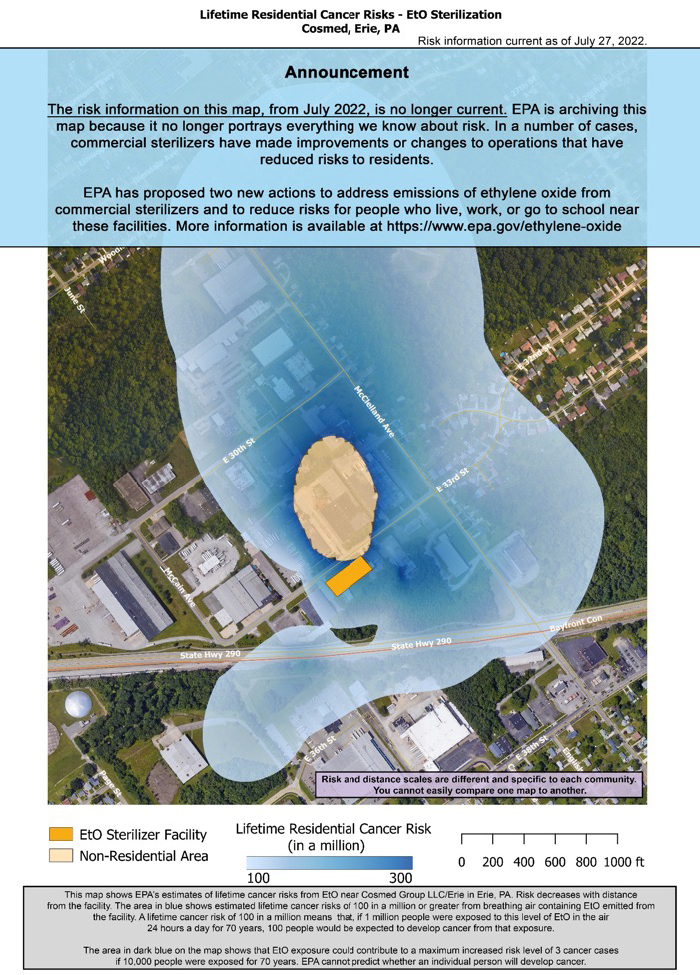Ethylene oxide and the EPA
Ethylene oxide (EtO) is a chemical found everywhere, produced naturally by our bodies and plants, along with waterlogged soil and fires. It is used in many consumer products but has a critical use in sterilizing medical equipment that cannot safely be treated with heat or moisture. There are approximately 100 commercial sterilization facilities in the U.S. Because ethylene oxide can be vented into the atmosphere, the EPA has a role  in regulating the industry under the Clean Air Act.
in regulating the industry under the Clean Air Act.
In April 2023, EPA proposed new regulations on sterilization facilities based on their 2016 revised Integrated Risk Information System (IRIS) assessment. As I have written, this assessment changed the EPA’s cancer risk description for ethylene oxide from “probably carcinogenic” to “carcinogenic” for humans based on faulty data and a model that significantly over-predicts lifetime cancer risk and is infrequently used in risk assessment. The EPA calculated exposure for a one-in-a-million lifetime cancer risk to ethylene oxide is 0.1 parts per trillion (ppt) in the air - a level 19,000 times below the amounts found naturally in the human body and 1,000 to 2,000 times below that found in typical urban air.
The workers and the surrounding communities are among the many individuals to be “protected” by these new regulations. How do citizens living near ethylene oxide sterilization facilities receive information on the potential health risks from these facilities? By turning to EPA’s facility-specific websites, such as that for residents living near the CosMed Inc. facility in Franklin, NJ, which misinforms the public and unnecessarily alarms residents and businesses near sterilization facilities.
“South Memphis is bearing an ethylene oxide ‘health emergency’”
Since August 2022, the EPA has engaged in community outreach to people living near 25 sterilization facilities where models have indicated an elevated cancer risk from ethylene oxide emissions. This outreach has resulted in fear and panic in some communities. The article discusses how EPA officials cautioned that the Sterilization Services of Tennessee facility pumps ethylene oxide into the air, creating an elevated cancer risk for nearby people. One woman stated, “I was devastated. I used to go outside to plant my garden and to cut my yard. I can’t do that anymore.”
EPA’s presentation at the community outreach meetings includes inaccurate and misleading statements.
- At the Franklin, New Jersey presentation, the public was told that “breathing in ethylene oxide over many years may cause breast cancer and lymphoid cancer.” A systematic review and meta-analysis of 30 studies published between the 2000s and 2010s, not included in the EPA’s 2016 IRIS assessment, “did not support the conclusion that exposure to ethylene oxide is associated with an increased risk of blood cancers or breast cancer.”
- The EPA states that “reduced ethylene oxide coming out of the facility is the best way to reduce risk” but neglects to tell the public that the human body naturally produces ethylene oxide at a concentration that is 19,000 times above the level that EPA uses to present “elevated risk.”
- The EPA tells the public that lifetime cancer risk is calculated based on “breathing air containing ethylene oxide at the level estimated at that location for 24 hours a day, every day for 70 years.” To state the obvious, this is a totally unrealistic scenario. But the EPA neglects to make clear that this unrealistic cancer risk is based on a model, let alone a model that may well over-estimate the risk.
- The map below shows EPA’s cancer risk for residents living near the CosMed sterilization facility in Franklin, NJ, indicating that people living in the area in blue have an elevated risk of cancer from ethylene oxide exposure. The EPA did not inform the public that the estimated cancer risk on the map is in addition to cancer risk from other causes, misleading the public into believing that the cancer risk is solely from ethylene oxide exposure. And while they write that the map is outdated because of reduced EtO emissions, what leaves the strongest impression, the words or that ominous blue cloud?

In issuing the proposed regulations for ethylene oxide sterilization facilities, the EPA is responsible for informing the public of the risks - information that is timely, accurate, and transparent. It seems that EPA has failed in all these areas.
If sterilization facilities have more up-to-date information on ethylene oxide emissions, the EPA should obtain and post that information. The current maps based on outdated information foster an environment of unnecessary fear in communities near sterilization facilities.




